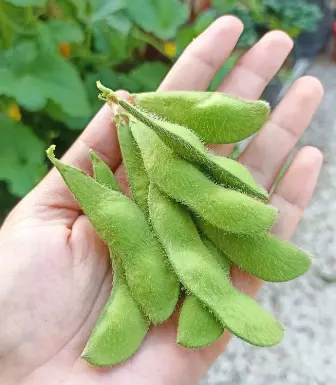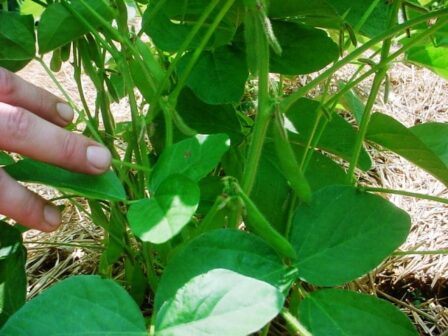But you can save money by growing edamame in your yard and making a recipe. So, how to grow edamame from store-bought?
Edamame can be easily grown in the yard like other vegetable beans. However, if you have purchased frozen edamame from the store, you must wait until it defrosts.
Rinse the beans and sow them in a well-drained loamy soil. The edamame usually takes 90-125 days to grow from seed to pod. Well, it’s just an approximate time, and you may see the pod earlier.
The article discusses edamame and how you grow it in your yard. So, keep reading this article to know more about edamame and its cultivation.
Growing Edamame From Store-Bought Beans
Edamame, or soybeans, originated in East Asia and is a new crop in North America, especially for home gardeners. But you can quite easily cultivate this plant.
It requires significantly less maintenance while growing. The beans are a powerhouse of various vitamins and minerals like calcium, protein, and many more.
The greed pods are steamed in water after harvesting. You will have two to three beans in one pod. The beans are removed from the pod, and you can pop them directly into your mouth. The beans have a sweet and buttery flavor.
Through various steps, let’s discuss how to grow edamame from the store-bought below.
1. Allow The Store-Bought Edamame To Defrost
You need first to defrost the store bough edamame. The purpose of defrosting is to bring the edamame seeds to an average temperature.
Now rinse all the seeds from the pods so that they will get ready to go into the ground.
There are various types of soybean seeds. If you want to eat the soybean seeds, purchase the frosted green variety Edamame and sow its seeds in the yard.
But if you’re going to make soymilk, then choose yellow variety frosted edamame.
2. Choose The Right Soil
Choosing the right soil is quite essential for the growth of edamame. Good soil has various benefits, like less erosion and weeds. There is even a proper balance of nutrients in the soil, which helps the plant’s proper growth.
The best soil for edamame is drained correctly loamy soil. Well, medium-fertility soil can also be suitable for plant growth. But if you have high clay content, you can mix peat moss or sand on it.
3. Sow Seeds At The Right Time
The edamame will give higher production when planted in May. You also need to consider soil temperature while sowing seeds.
So, the best time for sowing seeds is two weeks after the last frost. During that time, the soil temperature will be 70 degrees Fahrenheit, and the air temperature will be 60 degrees Fahrenheit.
4. Prepare Seed Bed
Preparing a seed bed is quite important. The plant will not grow well if the soil has too much or too few nutrients. So, if your soil has poor nutrients, add compost or manure before adding seeds.
5. Inoculation
Edamame needs a lot of nitrogen for proper growth. One of the best ways to provide nitrogen to the plant is by inoculating the edamame seeds with Bradyrhizobium japonicum. You can purchase this bacterium from online stores or gardening stores nearby.
Put some beans in the bucket and sprinkle the Bradyrhizobium japonicum. Take the help of a spade so that every bean should be well coated with the bacterium.
Remove the beans from direct sunlight after coating and sow them within 24 hours of inoculation.
6. Time To Sow The Seeds
Sow the soybean seeds at least 1.5 inches deep into the soil. There must be 3 inches distance from one bean to another. You need to water the soil just after sowing the beans. But don’t overwater the soil, as it can crack the beans.
7. Keep The Animals Away From the Shoots
Animals like rabbits love edamame shoots and can damage them. So, it’s best to put a fence over the area where you are growing the plant.

8. Remove Weaker Plants
The soy plants will start to sprout within two weeks. If you observe any weak plants, uprooting is the best so that the strong soy plant will develop effectively.
9. Weed Regularly
Weed disturbs the growth of the soy plant. The plant can get choked by the weeds. So, you need to remove the weeds regularly. You can pull out the weeds by using your hand.
But once the soy plant grows, you don’t have to worry about the weeds because they will now choke the weed.
10. Water the Plants
You need to water the plants frequently so the soil will always remain moist. The plant mainly requires extra water in three stages.
The first is when they have not sprouted from the soil, and the second is in the flowering stage. The third is when the plant is developing a pod. Never keep the soil dry in these three stages for proper growth of the edamame plant.
11. Time To Harvest

Edamame usually matures in September. When the pod becomes color green, you will know that it’s time for harvesting.
Ensure to pluck the pods before they turn a yellowish color. The pods will be at least 2-3 inches long when it is completely matured. The seeds will be completely developed at that time. Remove the entire pod from the edamame plant at the time of harvesting.
12. Blanch The Pods
Take a container and fill it with water. Boil the water with high heat. Now take another container and fill its half with normal water. Put some ice cubes over it.
Now take the edamame pods and put them in the hot water container. Allow the pods to boil for a few minutes, then take a spoon and remove all the pods. Now put the edamame pods in the container of ice cubes. Allow the pods to have an ice bath for almost 5 to 10 minutes.
Once all the pods are cooled down, remove them and place them on a clean towel. Blanching is reasonably necessary because you cannot digest the raw beans properly. Additionally, the pods become soft, and you can remove the bean squirt easily.
13. Remove The Edamame Seeds From The Beans
Now take the pod and remove the bean gently from it. You must pinch the edamame pods on both sides to remove the beans. Remove all the beans from the pods and keep all the beans in a clean bowl.
14. Either Use Or Store Beans
Ensure the soy seeds are entirely cool. You can eat them directly or store them for future use. You can store the soy seeds for several months to a year and use them in your favorite dishes.
Pests And Diseases In Edamame
1. Powdery Mildew
It is a fungus that the edamame plant can develop with time. The upper surface of the leaves will have a white coating at first, and later it will grow and cover the entire leaf. These diseases may change the color of the leaf and stunt the plant’s growth.
You need to remove the infected leaves from the plant. Additionally, allow proper air circulation near the plant. Ensure the plant receives the appropriate amount of sunlight to avoid fungal disease.
2. Whiteflies
When whiteflies infect the edamame plant, you will observe yellow or silver color areas on the plant’s leaves. The insect can stunt the growth of the plant or wilt the leaves. You should remove the infected leaves from the plant. Also, spray water on the leaves’ upper and lower surfaces to avoid insects.
3. Stinkbugs
Stinkbugs also affect the edamame plant and make yellow or white color blotches on the leaves. The pods even grow smaller in size because of stinkbugs. You can spray insecticidal soap on the nymphs to avoid stinkbugs.
4. Root Knot Nematodes
The root will become knotty, the plant will wilt, or all the leaves will turn yellow. To avoid root-knot nematodes, you must destroy the crop, including the roots.
FAQs
1. Is edamame easy to grow?
Edamame is relatively easy to grow. You can grow them either in a container or on raised beds. These plants grow up to 2 feet long, and you can harvest the beans after approximately 80 days of sowing seeds. You can plant the seeds on warm soil like other beans.
2. Do I need to soak edamame seeds before planting?
No, you don’t need to soak edamame seeds before planting. You can sow the edamame seeds 2 inches underneath the soil. There must be at least 3 inches distance between two beans for proper growth of the plant.
Conclusion
You can grow the plant in your backyard easily from store-bought edamame. The plant lives for a few months, and you can harvest the beans within 150 days or less.
You have to water this plant throughout the season. But don’t overwater the plant. Ensure the soil is always moist throughout the season.
Additionally, check the leaves and soil to know about the pests, and if they are affected, then take preventive measures accordingly. Remove the weeds from time to time. But be gentle while removing weeds because edamame roots are very delicate.
Follow the methods mentioned above for growing edamame in your yard. You can share photos after harvesting edamame. We will be glad to see those photos.
YOU MAY LIKE:
How to grow garlic from store-bought

